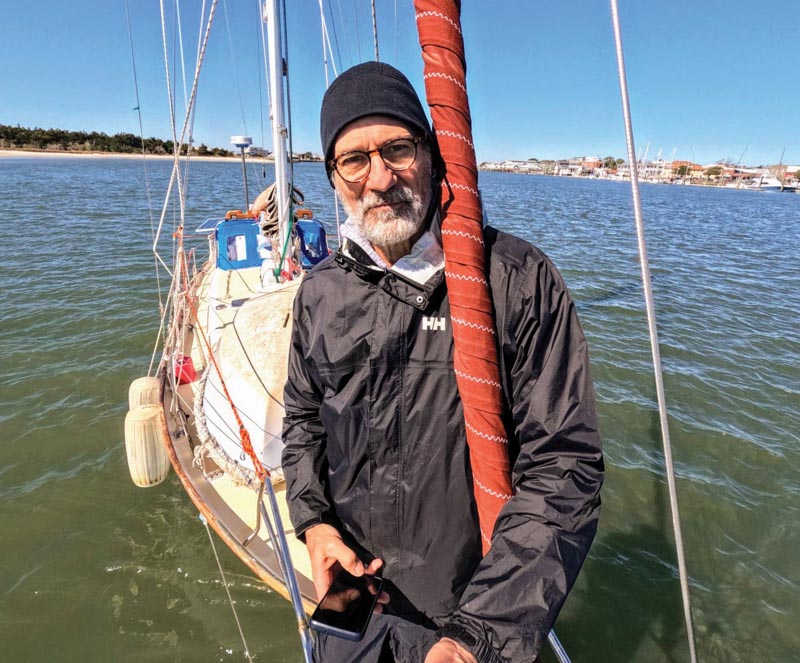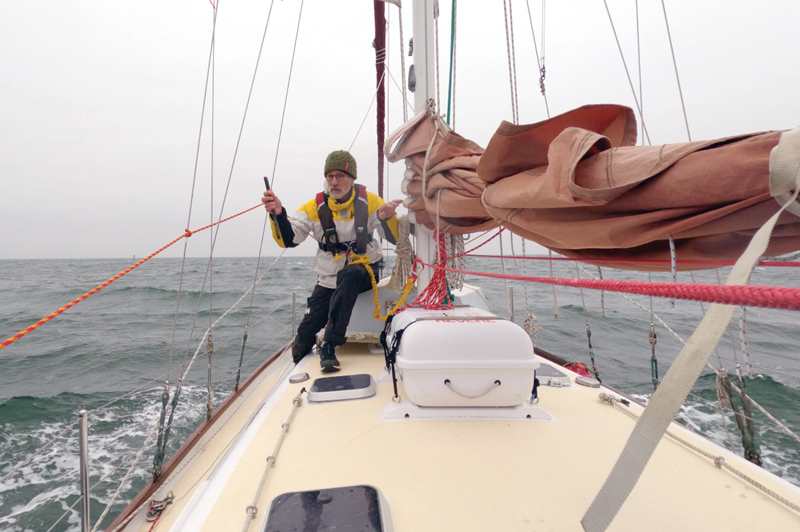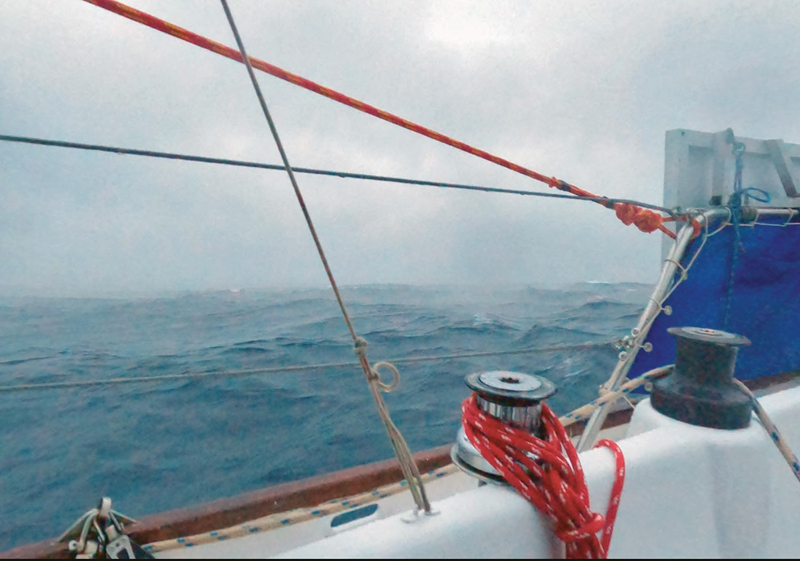I know how to stow. I know how to head to sea. Or so I had thought.
Sailing off Hatteras, the author certainly knew when it was time to heave to.
No sooner had I pointed the bowsprit north than I began to regret every decision I had recently made and none more than the farewell celebration that had taken place in my boat’s salon the night before. It was four miles from Little Creek Marina in Norfolk, VA, to the turn that would take me east and over the Chesapeake Bay Bridge-Tunnel. The winds were northeast and brisk. I motored hard into them in abject misery, hoping upon hope that my luck would change with the turn.

The two-blade bronze prop that propelled my 1967 Rawson 30 cutter Ave del Mar repeatedly lost its bite as she rose and fell, rose and fell, bashing into the Chesapeake Bay swell that pushed opposite our course. With every major bash her speed would drop—often to nearly zero—and slowly build back up as the prop regained its grip in the turbulent waters. It was about halfway up to the tunnel that I puked.
Ahh! Must tell Ben I vomited, I thought to myself. I had achieved near-seasickness only once before on a delivery aboard a catamaran with my friend Ben coming out of Rio Dulce, Guatemala, beating into a stiff easterly Caribbean wind that had us going bash! bash! bash! just like this. That time it didn’t quite happen. This time it quite did.
I eventually reached my mark and made the turn towards the east, letting out a scrap of jib that I hoped would flatten out the ride. It did not. My friend Matt—the guilty other half of the previous night’s departure celebration—texted me, saying, “After Cape Henry you’ll be good.” If this were to be true, Cape Henry couldn’t come fast enough. For now, I had simply traded beating into the winds on Ave’s starboard bow for beating into the winds on Ave’s port bow. It brought no relief to the ride. At least the urge to purge had come and gone.
The sky above me was the lifeless grey of a banker’s suit as mist—perhaps more than mist, but not quite rain—lay heavy and wet all around. Things believed to have been well-stowed belowdecks proved me wrong during the morning’s bashing. How could I have been so stupid? I know how to stow. I know how to head to sea. Or so I had thought.

With one push of the tiller...
Eventually, the turn around Cape Henry came, and Ave let me point her south. That brisk wind fell off to her port quarter. Sails went up. The engine went off. The ride smoothed out. With one push of the tiller my entire universe had changed. It continued through the night as I made for Beaufort, NC, my next stop and hopefully final staging ground for the trip to St. Martin. Through the darkness I flew, consistently over six and sometimes seven knots. The winds held steady in the high teens. I could feel speed records falling.
In the early hours of the morning the winds picked up and shifted more northerly. I adjusted course in the dark, but there were no sail changes and no drama—just me dozing and Ave screaming along as if we were on the Nevada salt flats.
Then it was time to heave to
With sunrise came stiffer winds that dug in firmly on the high side of 20 knots. Soon enough 20 became 25. In went the third reef on the main. Away went more jib. The rigging groaned and shuddered as 25 became 30, 32, and 35. Waves crashed over the decks, one barreling across the foredeck with enough force that I had to check to make sure I still had a dinghy. It felt as if I had been hit by a truck. It became obvious to me that it was time to heave to.
There was no chance of pointing upwind, so I manhandled the jib inch-by-clumsy-inch until it was furled, finishing it off with three tight wraps. I grabbed the mainsheet with both hands and pulled until the triple-reefed main was taut to center. I shoved the tiller to leeward, lashed it to the secondary winch with shock cord, and quick as that, everything stopped. I was hove-to, in a gale, off the Outer Banks. I sat in the cockpit for a while, almost unable to believe that the angry winds had been defanged so simply and so abruptly. Then, I went below, ate a sandwich, and slept.
Hove-to created a welcome sensory illusion
Throughout the day I would think that the worst of the blow was behind me and that it was time to let out some cloth and sail again, but out in the cockpit it never took long to realize how wrong that assessment was. You simply couldn’t feel the force of the storm from the salon when the boat was hove-to. It was sensory illusion.
“You sure you can’t run under it?” asked Ben by satellite text. “You’re getting awful close to the stream.” The Outer Banks lay to my west, Hatteras and Diamond Shoals to my southwest, and the Gulf Stream to my east. All three were worthy of avoiding. With my tether well secured to the cockpit padeye, I leaned out and touched a hand to the water. Still cool. The winds were just too much. Running meant bearing towards the shoals. Back belowdecks. Eat. Nap. Wonder. Wait.

When the time to sail again had come
It was late afternoon when the winds abated a bit, easing to 28 knots or so. Over the rail and into the Atlantic went my hand again, sinking into what felt like bath water. This was the edge of the stream. The time to sail again had come.
I centered the tiller, let out a very controlled 20 percent of the jib, and eased the mainsheet. Ave swung south-southwest. Away we went, off towards Hatteras and Diamond Shoals and the Graveyard of the Atlantic. Of course—nod to Ben—running does take the bite out of winds, and the mid-20s on my stern felt about as lethal as a kitten’s breath. The aftermath of the gale was evident in the seas that rolled in from behind and hoisted my boat and me skyward like Apollo—12- to 14-foot seas, large and slow and lumbering and not at any point feeling like a threat, even when the world disappeared from the depths of their troughs.
The red buoy of Hatteras came and went as Ave and I put a bit more west into our southwest, making for Cape Lookout and the eventual turn towards Beaufort. At 5 p.m. I hailed Marine Weather Center on the SSB radio, looking for more insight into the coming weather. Their advice was clear: if I could get in by midnight, I should get in by midnight. After that, apparently, those winds were going to clock again, and they weren’t forecast to be light.
The sails were wide open all the way to Cape Lookout Shoals, and when the shoals were behind me those same sails came down without hesitation. I started the engine and kicked the throttle forward. Beaufort’s seemingly random array of red and green lights lay scattered before me as I approached in light winds and kindly seas under a nearly full-moon that hung in the night sky like a hat on a peg.
In through the channel I crept, spotlight in hand and breadcrumbs on the plotter. The anchorage was empty. It wasn’t long before my Rocna and its chain were spilling over the roller. When the anchor bit, Ave swung around and settled down in the refuge of Beaufort’s inky midnight waters.
In the end the hardest parts had been pretty easy and the easiest parts had been pretty hard. I couldn’t help but wonder what surprises might be in store when it came time to head out again, when Beaufort became the next port to fade away behind me. For now, it was time to sleep—in the v-berth and without heaving to.
by John Herlig
About the Author: John Herlig lives aboard his Rawson cutter, Ave del Mar, teaches at Cruisers University, and is the host of the podcast Remarkable Stories. Find him on Instagram @sailing.ave.




